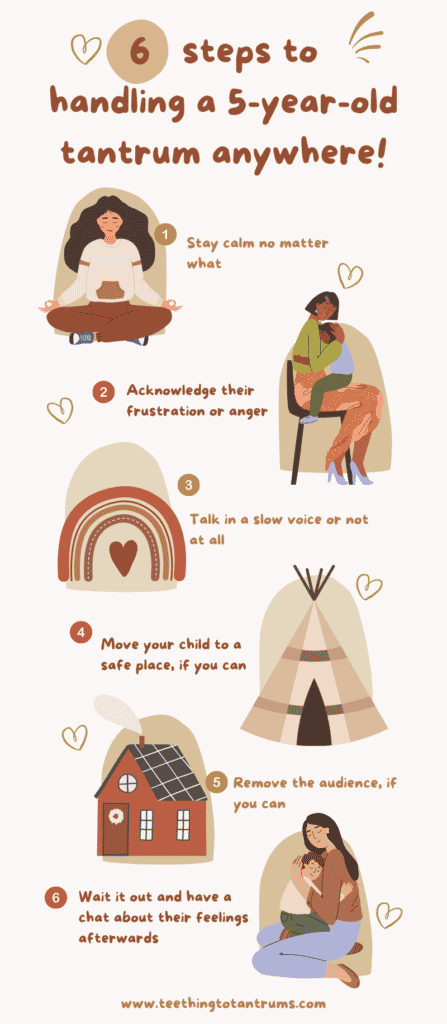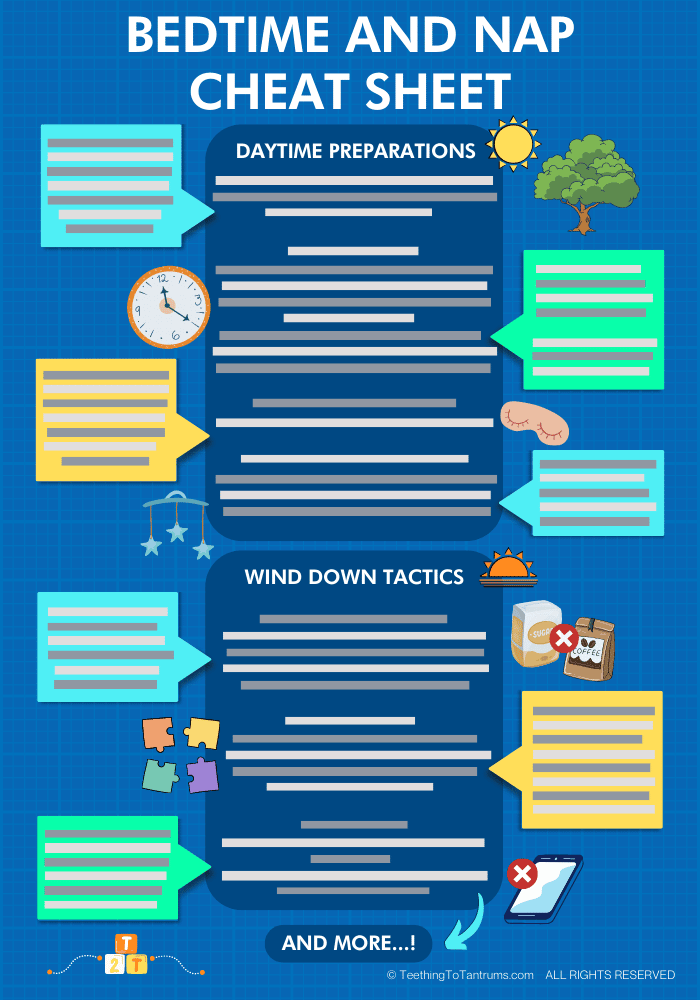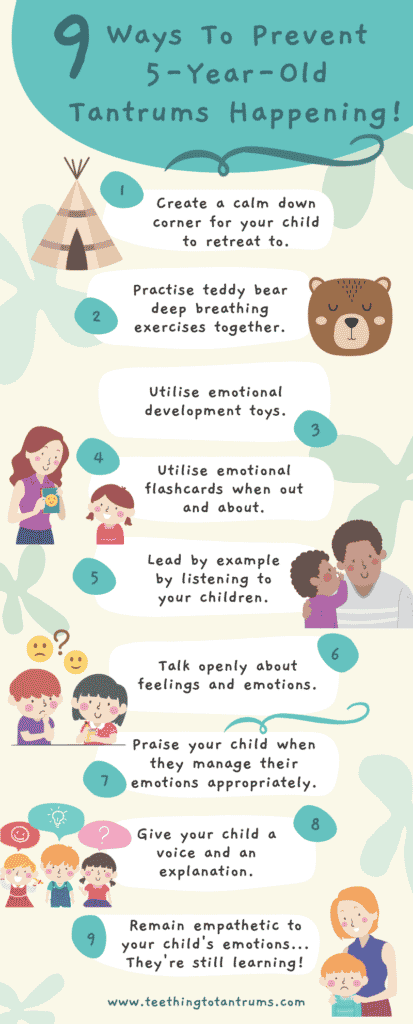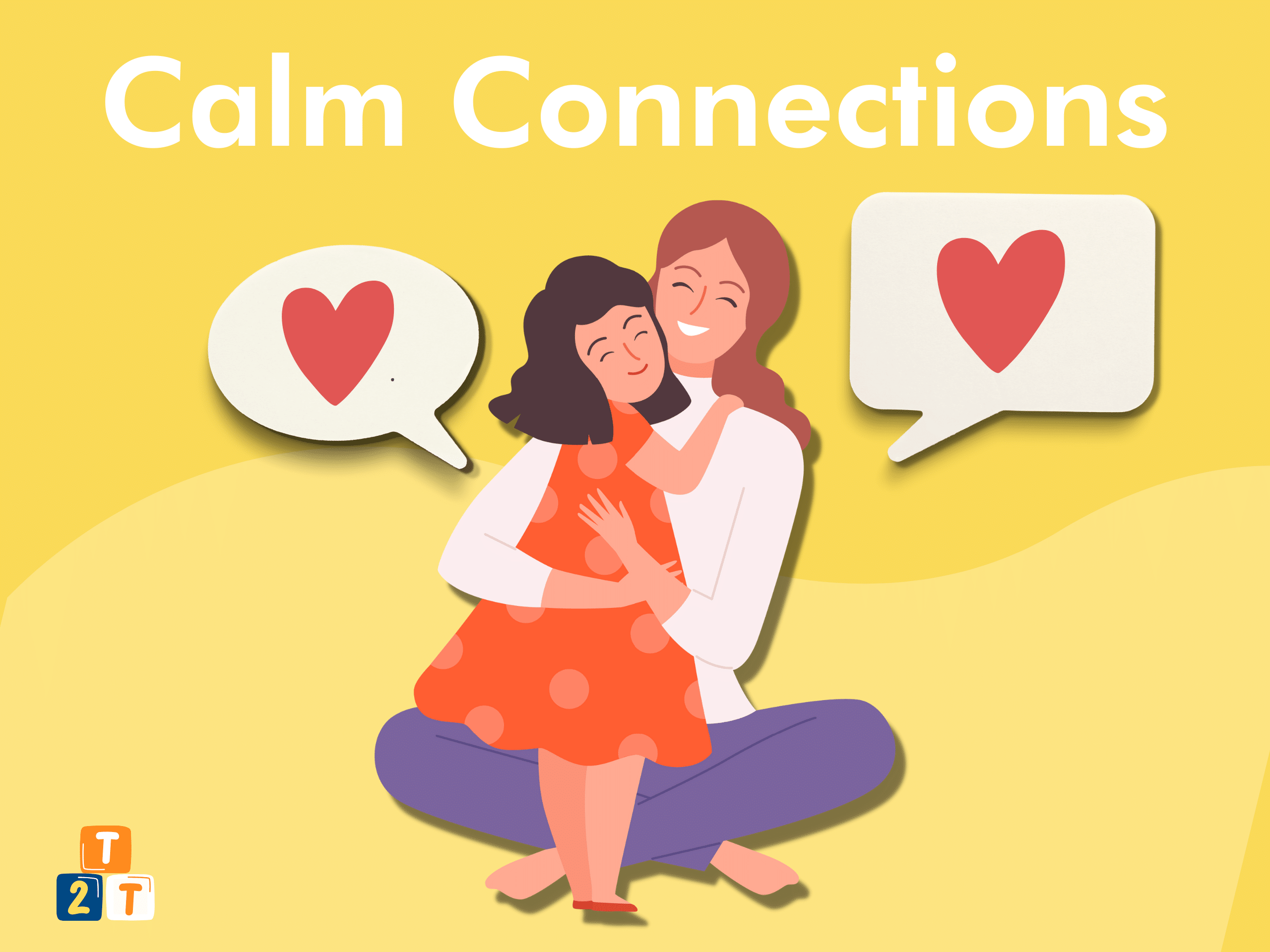Tantrums in 5-year-olds can be very stressful… Especially when they happen in public. So how can we handle these tantrums to diffuse the situation and what can we do to stop them from happening again?

Table of Contents
Key Takeaways
- Tantrums in 5-year-olds are a common behavior and are often a result of your child’s developing emotional and social skills.
- Tantrums can be caused by various factors such as frustration, fatigue, hunger, anxiety, and feeling overwhelmed.
- Effective strategies for dealing with tantrums in 5-year-olds include staying calm, understanding the reason behind the tantrum, addressing the underlying issue, not giving in to the demands, and setting clear boundaries for acceptable behavior
Is It Normal For A 5-Year-Old To Throw Tantrums?
Yes, it is normal for a 5-year-old to throw tantrums. Younger children have more frequent tantrums because they do not have the communication and emotional skills to express their wants appropriately.
It is not uncommon for 5-year-olds to throw tantrums and have emotional outbursts from time to time as a result.
In fact, according to a study by pediatric experts Laura L. Sisterhen and Paulette Ann Wy, “18 to 60-month-old children have tantrums once a day on average, lasting for three minutes”.
And yes, 60 months is equal to 5 years.
How To Handle Tantrums In 5-Year-Olds
Dealing with tantrums is never easy and dealing with 5-year-old tantrums can be even trickier depending on their source…
Here is a list of strategies you can use during a tantrum to help diffuse the situation and encourage your little one to understand their intense emotions:

Stay Calm
As hard as it can be to do, when your child is in a full-blown tantrum you have to do the opposite.
By taking a deep breath and staying extremely calm, you are modeling to your child a calm, unwavering, safe space to return to.
Acknowledge Their Frustration Or Anger
Toddler tantrums can occur when your child feels ignored or unheard.
Therefore, you should acknowledge that you understand their feelings of anger or frustration and that when they calm down, you can talk about it together.
Talk In A Slow Voice Or Not At All
Tantrums in 5-year-olds often happen when your child wants a reaction from you. So, sometimes it is best not to say anything at all when a tantrum is happening.
But if you do have to talk them through a process or acknowledge their emotions… speak in a slow, confident and neutral voice.
Move Your Child To A Safe Place, If You Can
If your child is thrashing about, trying to throw things, and hitting nearby objects, then move them to a safe place, if you can.
This can also help to stop a tantrum as you may be removing them from a triggering environment.
Remove The Audience, If You Can
It is natural to feel embarrassed if your child kicks off in public… But remember, your child throwing a tantrum is NOT a sign of you being a bad parent.
And by moving to a more private location you can concentrate on dealing with the tantrum without worrying about what others are thinking.
Wait It Out And Have A Chat
Finally, you will just have to see the tantrum through.
You cannot do anything constructive mid-tantrum and if you rush it, your child will not learn how to handle these emotions in the future.
So, regardless of what is happening, slow down and wait for the tantrum to end.
Once it is over, you can then have a conversation with your 5-year-old about their tantrum and educate them about a more appropriate way to express their emotions by developing their communication skills.
REMEMBER: Being 10 minutes late is not the end of the world, but teaching your child between acceptable and bad behavior when handling their emotions will certainly be worth every second.
7 Causes Of 5-Year-Old Tantrums
Most 5-year-olds will be having tantrums because of:
- Overtiredness
- Hunger
- Overstimulation
- Not feeling heard
- Anxiety
- Sibling Rivalry
- Or not getting their own way…
Some children throw tantrums because they have worked in the past to get what they want. So your 5-year-old is now choosing to throw a tantrum in order to get a certain reaction from you.
Think overtiredness is triggering your 5-year-old’s severe tantrums? Check out my Bedtime and Nap Cheat Sheet to master the art of making daytime naps and bedtimes as seamless as possible and say bye-bye to tantrum triggers for good.
A bedtime & nap cheat sheet so good your little one will ask you to put them to bed...
Laura Williams "This is a life saver! I'm so glad I downloaded your bedtime & nap cheat sheet. My little one actually asked me to put him to bed last night! Unbelievable! Thank you so much!"
Click Here For The FREE Cheat Sheet
3 Things You Should NEVER Do When Your Child Is Having A Tantrum
So, it’s all good knowing what to do when 5-year-old tantrums are happening…
But what are the key things that you must NEVER do when your child is throwing a tantrum?
- Don’t raise your voice. Raising your voice will just escalate the situation. As hard as it may seem, try to stay calm and collected during your 5-year-old’s tantrums.
- Don’t give in. If your child is throwing a tantrum because you have said ‘no’ to something they wanted… do not be tempted to go back on your word. Once you give in to your 5-year-old’s demands, they will continue to throw toddler temper tantrums to get their own way in the future.
- Don’t try bribing or negotiating. Bribing a tantrum-throwing 5-year-old results in giving the unwanted behavior a reward and the power to manipulate the situation. Children are very clever and just like giving in, negotiating, begging and bribing will encourage bad behavior and your child will throw more tantrums to get what they want in the future.
PS: Here’s a quick video to help you deal with your 5-year-old tantrums from Jordan Peterson that will also help you understand that you’re not going through this difficult time alone.
How To Prevent Tantrums In 5-Year-Olds From Happening
As well as the above actions being useful for handling a 5-year-old tantrum when it’s happening…
These are my top tips to prevent severe tantrums from even getting going:

1. Create A Calm Down Corner For Your 5-Year-Old To Self-Regulate
Having a designated calm down corner for your child to retreat to when they are feeling angry or frustrated can really help to divert severe tantrums in 5-year-olds.
Making the calm down corner as cozy as possible with a tent and lots of cushions will help your child to feel safe in a neutral environment where you can then go and encourage them to talk about how they are feeling in a non-intimidating place.
2. Practise Teddy Bear Deep Breathing
Deep breathing is a great way to calm down after frustration tantrums but is not always easy to teach to a young child.
Therefore, teddy bear breathing is a fun way for your child to learn this useful skill.
Balance a teddy bear on their tummy and give it a ride with the rising and falling of their breath. It is a great idea to make this part of the bedtime routine when you are lying down and want to calm down for the evening.
Super soft, very cuddly and the perfect companion to young children, the GUND Teddy Bears never fail to be toy box favourites for years to come!
3. Utilise Emotional Development Toys
Using emotional developmental toys such as the Little Spot Range of emotional toys can encourage your children to talk about their feelings and emotions in a healthy way.
They are especially useful after an outburst when you are trying to talk about how they were feeling before and during the tantrum and what triggered it.
What is it? This book contains 8 different plush toys each displaying a different emotion - Anger, Anxiety, Peaceful, Sadness, Happiness, Love, Confidence and Tangled (Scribble) - to help children identify and process their emotions.
Why do I like it? This is a very helpful tool to teach children about emotions and how to handle them. Its fun plush toys make learning about emotions manageable and approachable. The Little SPOT of Emotion book is also ideal for children with social-emotional needs.
4. Utilise Emotional Flashcards
Emotional flashcards are also a great way to get your children to talk about their big feelings. Similar to the emotional plush toys, these flashcards are great to use when you are out and about and you can sense the onset of tantrums and you want to divert their attention towards positive behavior.
5. Lead By Example
Teaching your child good listening skills by leading by example and listening to what they have to say, can also go a long way in avoiding unnecessary tantrums as your child will feel heard and acknowledged.
6. Talk Openly About Emotions And Feelings
Generally, is very important for your 5-year-old to understand emotions and feelings as they may be struggling to deal with them!
So as well as using the flashcards and emotional toys, regularly explain to your 5-year-old that having these emotions is not a bad thing, but that they must be expressed in an acceptable manner.
7. Praise Your Child When They Manage Their Emotions Appropriately
Praising your child when they manage their anger, frustrations, or emotional outbursts in a positive and acceptable way will reinforce positive behavior and help to reduce severe tantrums in the future.
8. Give Your Child A Voice And An Explanation
5-year-olds are typically trying to find out how their feelings and the world works around them and as a result, they will appreciate the opportunity to ask you questions and get explanations from you.
Again, by being present and taking the time to explain a situation thoroughly, your child will feel heard and will be less likely to throw a tantrum out of frustration and misunderstanding.
9. Remain Empathetic
I know I mentioned this when your 5-year-old is having a tantrum, however, it is equally as important to remain empathetic to your child’s emotions when they are not having a tantrum too.
Acknowledging that you understand how or why they are feeling the way they do in any situation will help them to know you care for them all the time and will ensure they feel heard if they do happen to have a tantrum.
REMEMBER: Knowing how to predict tantrums in 5-year-olds is just as important as knowing how to deal with them. Encouraging your child to talk about their feelings and use words rather than using physical outbursts to express themselves is key to preventing tantrums.
Want to stop your children from yelling, shouting & throwing tantrums… Whilst helping them listen to you and building a healthy strong relationship? Look no further than Calm Connections and transform your family’s life for years to come.
- Understand the best way to communicate with your child in different situations, so you feel more confident, relaxed, and in control... even during the most challenging moments. 💖
- Learn how to set clear boundaries and engage your child's cooperation 🌟
- Break free from tantrum cycles and promote healthy alternatives (without using punishment) 🎉
- Learn my trade secrets (collected over 40+ years in the childcare industry) to get your child to listen to you without shouting 🙌
- Promote kindness and honesty to prioritize a respectful relationship with your child ❤️
What Is A 5-Year-Old Tantrum?
A tantrum is an eruption of emotion born out of your child’s frustration to not getting what they want, stress, anger, hunger, or tiredness. This can result in your 5-year-old kicking, screaming, crying, hitting, and biting to get your attention.
What Is The Difference Between A Tantrum And A Meltdown?
The main difference between meltdowns and typical tantrums in 5-year-olds is that:
A tantrum happens when a child is frustrated or angry, while a meltdown occurs when a child is emotionally or sensorily overloaded.
Therefore, during a tantrum, your child will still have some element of control over their destructive behavior and the tantrum will usually end once they have got what they want.
But with an emotional meltdown, your child will struggle to calm down and will only do so once they have been removed from the situation that caused the meltdown in the first place.
However, some severe tantrums can turn into meltdowns if they go on for a long time.
| Characteristics Of A Tantrum | Characteristics Of A Meltdown |
| Tantrums are a normal reaction to feeling frustrated, angry, or not getting their own way | Meltdowns are an instinctive reaction to feeling overwhelmed or being unable to handle strong emotions such as fear, anxiety, or sensory overload |
| Your child will remain partially verbal and communicative during a tantrum | During a meltdown, children are less verbal and communicative |
| Tantrums are goal-driven and remain under your child’s control | Meltdowns are often out of a child’s control or ability to reason |
| Tantrums are driven by a desire for attention or happen due to your child not being able to communicate what they want | Meltdowns are a child’s normal reaction to feeling frustrated, angry, or upset |
| Children will watch to see what your reaction is and the tantrum will stop once your child’s goal has been achieved | Meltdowns are usually long-lasting (often referred to as prolonged tantrums) and will only end once your child has regained emotional composure |
| Once the tantrum is over, children will recover quickly. | After a meltdown, children will struggle to calm down and often become withdrawn |
If you suspect that your 5-year-old is experiencing meltdowns instead of tantrums, click here to get specific advice on how to handle emotional meltdowns in children.
When To Seek Help For 5-Year-Old Temper Tantrums
In some cases, temper tantrums in a 5-year-old can be an indication of an underlying behavioral disorder linked to child development and not being able to process emotions effectively, such as autism spectrum disorder (ASD) or attention deficit hyperactivity disorder (ADHD).
If you notice any of the following signs, then I would advise having a chat with a medical professional or child psychologist to see if an emotional assessment would be useful:
- Severe tantrums are happening more often, are getting worse and last longer (over 25 minutes are indicative of serious issues).
- If your child struggles to calm down after an outburst
- Your child tries to hurt himself or others (self-injurious behavior has to be taken very seriously.)
- Your child always opposes you, argues a lot and hardly ever cooperates with you.
- Negative behavior is displayed far more often than positive behavior.
- Extreme aggression, anxiety, and poor emotional control dominate your child’s day.
Frequently Asked Questions About Tantrums In 5-Year-Olds
Looking for more information about tantrums in 5-year-olds and how to prevent and handle them? Here are the most frequently asked questions answered just for you.
Q: How to deal with bedtime tantrums in 5-year-olds?
A: Bedtime tantrums in 5-year-olds can be particularly frustrating, but there are some ways to deal with them. Firstly, establish a consistent bedtime routine and stick to it. Secondly, create a calm and relaxing environment in the bedroom, with dim lighting and minimal noise. Finally, try to address any underlying issues that may be causing the tantrums, such as anxiety or fear of the dark. If you’re still struggling with toddler bedtime tantrums (or even night tantrums) after trying these tips, learn my secrets to unlocking peaceful evenings once again with The Bedtime Battles Masterclass.
Q: When should I worry about my 5-year-old’s tantrum?
A: You should worry about your 5-year-old’s tantrums if they are frequent, severe, lasting longer than 25 minutes, or causing harm to themselves or others. If the tantrums are interfering with their daily life or development, or have been consistently going on for over a month, it may be worth seeking advice from your healthcare professional.
Q: Why is my 5-year-old so angry and aggressive?
A: There are many reasons why a 5-year-old may be angry and aggressive, including feeling frustrated, fatigued, hungry, anxious, and overwhelmed. It is important to try and understand the underlying reason behind the behavior and address any issues that may be contributing to it.
Q: How can I help my 5-year-old with anger outbursts?
A: There are several ways to help a 5-year-old with anger outbursts, including staying calm, providing a safe and supportive environment, teaching coping skills for managing emotions, and setting clear boundaries and consequences for behavior. Teaching children how to self-regulate can be a powerful tool in preventing tantrums.
Q: My 5-year-old holds his breath when upset. Is this normal?
A: Yes, breath holding is normal. According to a study published in the Journal of Pediatrics, “breath-holding spells are relatively common in young children, with up to 5% of children experiencing them”. While they can be alarming to parents, they are generally harmless and tend to resolve on their own by the age of 5 or 6. Most of the time it is just your child trying to get a reaction from you. However, if the breath-holding spells are frequent or severe, it may be worth seeking advice from a healthcare professional or mental health specialist to rule out anything more serious.
Q: Is it normal for a 5-year-old to be aggressive and throw violent tantrums?
A: It is normal for 5-year-olds to display a low level of aggressive behavior, as this is a common learning curve in young children. However, it is important to address the behavior and teach the child appropriate ways to express their emotions. Remember, one of the most common underlying issues for tantrums in 5-year-olds is frustration with not being able to communicate effectively. However, if the aggression is frequent or severe, or it results in violent tantrums, I would suggest seeking advice from a healthcare professional to rule out any underlying issues.
Q: How to deal with 6-year-old tantrums?
A: Dealing with tantrums in 6-year-olds is similar to dealing with tantrums in 5-year-olds. It is important to stay calm, understand the reason behind the tantrum, address any underlying issues, and set clear boundaries for behavior. Other strategies include distraction, positive reinforcement, and giving the child some space to calm down.
Q: Why does my 5 year old have so many tantrums?
A: There are many reasons why your 5-year-old has so many tantrums, including feeling frustrated, hungry, impatient, tired, worried, or overwhelmed. To stop a temper tantrum, it is important to stay calm, provide a safe environment, support healthy alternatives, and teach frustration tolerance skills. Sibling rivalry can also be a trigger for tantrums, so it is important to encourage positive sibling relationships too.
REMEMBER: Dealing with tantrums is never easy… But at 5 years old your child is capable of learning how to handle their emotions and communicating how they feel. This will then help to reduce the chances of temper tantrums happening in the future.
Need More Parenting Help?
- Download our FREE Bedtime & Nap Sleep Cheat Sheet. It’s a free, easy-to-use and proven formula designed for parents of 0-5 year olds to master the art of consistently undisturbed and restful sleep without the yelling, nagging or exhausting long-winded evenings.
- Check out our Parenting Toolbox. You’ll get access to expertly-chosen products that you can guarantee are the best for your little one and your wallet.
- Are you looking for personalized guidance to navigate the challenges of parenting? I offer 1-on-1 consultations to bring you tailored strategies and actionable advice to help support your child's growth and well-being with confidence.

A bedtime & nap cheat sheet so good your little one will ask you to put them to bed...
Laura Williams "This is a life saver! I'm so glad I downloaded your bedtime & nap cheat sheet. My little one actually asked me to put him to bed last night! Unbelievable! Thank you so much!"
Click Here For The FREE Cheat Sheet






